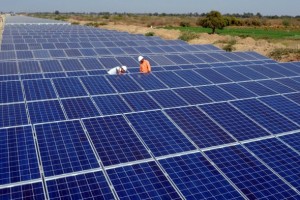
Watching SunEdison’s Collapse, Solar Industry Resets
Watching SunEdison’s Collapse, Solar Industry Resets
SunEdison’s collapse and mounting losses elsewhere are causing solar developers to change course.
Saddled with more than $11 billion in debt and facing at least one investigation by federal officials plus a lawsuit from its own subsidiary, solar giant SunEdison is lurching toward bankruptcy. The shares of other leading solar providers, including SolarCity and Sunrun, have lost more than half their value in the last four months as investors lose confidence in the no-money-down, 20-year-lease model that has fueled the explosive growth of the rooftop solar market in the last few years. Even though Congress has extended the investment tax credit, which provides credits worth 30 percent of the value of installations, that growth is expected to slow as the developers focus on improving their balance sheets rather than fueling breakneck expansion (see “Tax Credit Extension Gives Solar Industry a New Boom”).
“The market landscape is changing,” says Lyndon Rive, SolarCity’s CEO. Supported by government subsidies and financing from big banks, solar companies for years have been able to dramatically increase installations year by year, even while losing money. But the collapse of SunEdison made clear the perils of too-rapid growth.
SolarCity installed 870 megawatts of solar projects in 2015, 73 percent more than in 2014, and its revenue climbed to nearly $400 million, 56.7 percent above 2014. But the company continues to lose money: nearly $769 million for the year, more than doubling its 2014 losses. Similarly, Sunrun lost $28.2 million in 2015 even as revenue climbed 53 percent. There is little evidence that the major solar developers will become profitable this year or next.

So even at a time when demand and revenue continue to rise, the efficiency of the technology continues to improve, and installation costs are going down, rooftop solar is facing a major retrenchment. The reset is causing executives to rethink their business strategies and outsiders to ask: how can rooftop solar photovoltaics be turned into a viable, profitable business?
The companies’ answer is by cutting costs. For years, says Jonathan Koomey, a research fellow at the Steyer-Taylor Center for Energy Policy and Finance at Stanford University, rapid declines in the price of solar panels have driven the cost of installations steadily down in terms of dollars per kilowatt-hour. But that’s not enough. Now companies must achieve similar price cuts in everything that surrounds the panels, the so-called soft costs: overhead, labor, marketing, permitting, and so on. “The cost of the panels has fallen so far that it’s less and less an issue,” Koomey says.
The advent of smaller, highly efficient panels will save money by reducing the associated hardware, cutting the labor needed to install them, and making design and permitting easier. Both Rive and Sunrun’s CEO, Lynn Jurich, say they will wring further costs out by reducing overhead, automating systems, and lowering the cost of signing up new customers. Sunrun, for example, has reached in-store marketing deals with retailers such as Costco and Home Depot that will expand the company’s reach. And the companies are throttling back: both Jurich and Rive forecast growth rates, in terms of new installations, of around 40 percent for 2016 over 2015—still fast, but below the expansions seen in 2014 and 2015, which topped 75 percent.
Still, it’s not certain that cost-cutting alone will bring these companies to profitability once the solar tax credits expire in 2022. Solar installers, which have based their business models on rapid growth through customer-friendly leasing deals that impose high up-front costs on the companies, now find themselves in a somewhat vicious cycle: to keep funding new installations they must keep raising money. And to keep raising money they must keep signing up new customers. “Once you’re on that treadmill, it doesn’t stop,” says Raj Prabhu, the CEO of Mercom Capital, which tracks financial data in the clean-energy sector.
But at some point, they must show a profit.

Leave a Reply